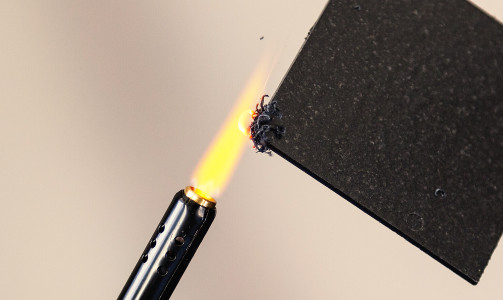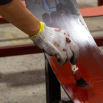
High-Temperature Expandable Graphite for Engineering Polymers
High Temperature Expandable Graphite from LUH is able to be used in thermoplastics without expanding during the extrusion process.

A coating can cover a wide range of applications, including indoor decorative, outdoor, industrial, and protective, to name a few. A protective coating is sometimes more challenging as it has to withstand harsh weather to last as long as possible, as they are often difficult and costly to reapply to the substrate. Coatings like these require specialist formulations that can preserve the coating and protect the substrate. In this article, we explore the mineralogical characteristics of MIO, its classification, and the key performance benefits it brings to protective coating systems, particularly in harsh environments where durability and long-term protection are paramount.
Micaceous Iron Oxide (MIO) is a naturally occurring mineral ore, which, from the point of chemical composition, is iron oxide (hematite) but with a very platy (or lamellar) morphology. This structure allows overlapping and alignment, providing unique barrier properties upon film formation that make MIO an ideal functional filler in high-performance protective coatings that can resist the permeation of water, oxygen and corrosive gases.
MIO deposits, although geologically rare, are found in several parts of the world, including Spain, Austria, China, Australia, and Africa. Since MIO is a naturally occurring material, there are regional differences in colour (dark red to metallic-like grey) and platy content depending on its geographical source and mineral processing methods.
To standardise performance expectations, MIO can be classified on a scale of 1 to 3 depending on the proportion of thin flake content. High-purity, high-performance MIO grades exhibit high platy content and minimal contamination from non-lamellar iron oxides; therefore, a higher number represents a better grade of MIO.
| Scale | Classification |
| 1 | >50% less than 10 micron thin flake content |
| 2 | between 10 to 50 microns thin flake content |
| 3 | over 50 microns thin flake content |
Table 1: MIO can be characterised based on its flakey content; this table shows the criteria for the scale of 1 - 3.
Materials from different mines will also differ by the percentage of platy content. Superior, high-quality grades will have a platy content of around 95%. This high level of platy content leads to better overlap of particles and therefore superior barrier properties to prevent the transport of water to the substrate. The Ferroxid range of MIO products from our partners Oxidos Ferricos (Spain) typically exhibit this superior level of platy content.
MIO is mostly used for water resistance in protective coatings, which protect large structures such as bridges, oil rig platforms, and other large structures or high-value assets, where the longevity of the coating is crucial to avoid frequent recoating. The water resistance is provided by the aforementioned platelet overlapping and being an inert mineral that itself does not react to the external factors.
The unique properties of MIO are not just restricted to well-established coatings applications. The robust, platy nature of the material lends itself well to providing acoustic insulation and vibration dampening. This is mostly applicable in sound-proofing driver cabins in construction and agricultural vehicles.
The high density of MIO also makes it a suitable filler when increased weight is required, while the shiny metallic appearance can be utilised for its aesthetic effect in decorative paints and plasters.
In the construction market, MIO can be used in the manufacture of damp-proof membranes.

Figure 1: MIO can be used for less demanding applications to give shiny metallic appearances.
Protective coatings for particularly high-end and severe conditions have to withstand a lot and can often lead to coating failures, which would require reapplication. For some, reapplication is a time-consuming or expensive process and so avoiding these failures can save a lot of money. MIO has the capacity to avoid many of these failures, including the below;
MIO largely imparts protection from these modes of failure due to its platy nature. The platelets can align themselves and overlap in the horizontal plane within the coating, creating a physical barrier which largely obstructs the permeation of water and gas. Any water which does penetrate the surface is likely to return to the atmosphere by micro-permeable dissipation.
The platy nature of MIO also offers protection to the underlying resin from UV light exposure. In epoxy systems, for example, the resin exposed to the environment tends to eventually chalk when exposed to UV light. This material will eventually weather off, exposing only the shiny MIO, which protects the resin beneath the coating surface.
Other mineral fillers are often utilised in the formulation of protective coatings with the aim of imparting similar benefits. These other minerals would include phlogopite and muscovite micas for example. However, where MIO appears to excel is in inter-coat adhesion and long-term overcoatability as well as having a more pronounced metallic aesthetic compared to other mineral varieties.
It has been reported that there are synergistic effects of using MIO in conjunction with zinc dust in heavy-duty protective coatings. The combination of the sacrificial anode (zinc dust) and the barrier properties of MIO can impart significant performance gains.
It is also possible that combining MIO with other hydrophobic surface-treated fillers or Asconium, the high-performance liquid corrosion inhibitors that we represent from ASCOTEC, could also yield interesting synergies.
Micaceous Iron Oxide is a valuable tool for industrial and protective coatings, increasing longevity and overall performance. Whether you have a potential coating application or another application which could benefit from the properties of MIO, please contact your Lawrence Industries account manager or reach out to us via the contact form to discuss which grade could work in your specific formulation.




High Temperature Expandable Graphite from LUH is able to be used in thermoplastics without expanding during the extrusion process.

Micaceous Iron Oxide (MIO) is a naturally occurring iron oxide used in protective coatings due to a lamellar/platy morphology that allows it to form a barrier towards the ingress of water.

Thermochromic pigments, such as Chromazone®, enable formulators to create products with dynamic and heat-sensitive, colour changes. These smart materials have found their way into various applications, from functional safety indicators to eye-catching promotional products. For example, reversible thermochromic pigments are used in novelty mugs that reveal hidden designs when filled with hot beverages, packaging that signals when food or drink is at the optimal temperature for consumption, security labels for brand protection and anti-counterfeiting, and temperature-sensitive warning indicators on surfaces or medical devices.